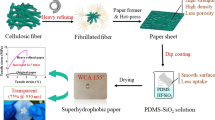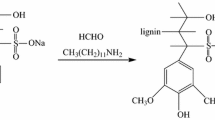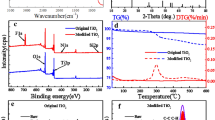Abstract
Herein, an eco-friendly and straightforward method was provided for the fabrication of superhydrophobic paper from native wood cellulose fibers via in situ hydrolysis of tetraethyl titanate(IV) without any chemical pretreatment. By simply adjusting the amount of acetic acid (HAc), the surface micro/nanomorphology could be well controlled. After papermaking and hexadecyltrimethoxysilane modification, superhydrophobic paper can be easily achieved with static water contact angle of 152.3° (± 1.3°). The paper also possessed good self-cleaning property against contamination and durability toward mechanical damages of finger wiping over 50 cycles as well as excellent oil/water separation, which expands its utility in various paper-based technologies. The whole procedure possesses the advantages of friendly raw material, mild reaction conditions and with no toxic modifier, which hold potential application in cellulose-based superhydrophobic material in large scale.









Similar content being viewed by others
References
Ghasemi S, Tajvidi M, Gardner DJ, Bousfield DW, Shaler SM (2018) Effect of wettability and surface free energy of collection substrates on the structure and morphology of dry-spun cellulose nanofibril filaments. Cellulose 25:6305–6317
Nechyporchuk O, Yu J, Nierstrasz VA, Bordes R (2017) Cellulose nanofibril-based coatings of woven cotton fabrics for improved inkjet printing with a potential in e-textile manufacturing. ACS Sustain Chem Eng 5:4793–4801
Tarrés Q, Oliver-Ortega H, Ferreira PJ, Pèlach MÀ, Mutjé P, Delgado-Aguilar M (2018) Towards a new generation of functional fiber-based packaging: cellulose nanofibers for improved barrier, mechanical and surface properties. Cellulose 25:683–695
Hirotaka K, Masaya N, Akira I (2017) Ionic liquid mediated dispersion and support of functional molecules on cellulose fibers for stimuli-responsive chromic paper devices. ACS Appl Mater Interfaces 9:40914–40920
Ngo YH, Li D, Simon GP, Garnier G (2013) Formation of polyelectrolyte-gold nanoparticle necklaces on paper. J Colloid Interface Sci 405:71–77
Wan C, Jiao Y, Li J (2017) A cellulose fibers-supported hierarchical forest-like cuprous oxide/copper array architecture as a flexible and free-standing electrode for symmetric supercapacitors. J Mater Chem A 5:17267–17278
Duan C, Meng J, Wang X, Meng X, Sun X, Xu Y, Zhao W, Ni Y (2018) Synthesis of novel cellulose-based antibacterial composites of Ag nanoparticles@metal-organic frameworks@carboxymethylated fibers. Carbohydr Polym 193:82–88
Kong X, Zhang J, Xuan Q, Lu J, Feng J (2018) Superhydrophobic coating for antifouling of chinese paintings. Langmuir 34:8294–8301
Zhang JC, Chen FZ, Lu Y et al (2020) Superhydrophilic-superhydrophobic patterned surfaces on glass substrate for water harvesting. J Mater Sci 55:498–508. https://doi.org/10.1007/s10853-019-04046-x
Su X, Li H, Lai X, Zhang L, Liang T, Feng Y, Zeng X (2017) Polydimethylsiloxane-based superhydrophobic surfaces on steel substrate: fabrication, reversibly extreme wettability and oil–water separation. ACS Appl Mater Interfaces 9:3131–3141
Gao A, Yan Y, Li T, Liu F (2019) Biomimetic urchin-like surface based on poly (lactic acid) membrane for robust anti-wetting and anti-bacteria properties. Mater Lett 237:240–244
Guo DY, Hou K, Xu SP, Lin YG, Li L, Wen XF, Pi PH (2018) Superhydrophobic-superoleophilic stainless steel meshes by spray-coating of a POSS hybrid acrylic polymer for oil–water separation. J Mater Sci 53:6403–6413. https://doi.org/10.1007/s10853-017-1542-3
Yin K, Du H, Dong X, Wang C, Duan J, He J (2017) A simple way to achieve bioinspired hybrid wettability surface with micro/nanopatterns for efficient fog collection. Nanoscale 9:14620–14626
Yin K, Yang S, Dong X, Chu D, Duan J, He J (2018) Robust laser-structured asymmetrical PTFE mesh for underwater directional transportation and continuous collection of gas bubbles. Appl Phys Lett 112:243701–243705
Yu M, Lin B, Chen S, Deng Q, Liu G, Wang Q (2018) Biomimetic fabrication of superhydrophobic loofah sponge: robust for highly efficient oil–water separation in harsh environments. RSC Adv 8:24297–24304
Seeharaj P, Pasupong P, Detsri E, Damrongsak P (2018) Superhydrophobilization of SiO2 surface with two alkylsilanes for an application in oil/water separation. J Mater Sci 53:4828–4839. https://doi.org/10.1007/s10853-017-1925-5
Cheng Q, Ye D, Chang C, Zhang L (2017) Facile fabrication of superhydrophilic membranes consisted of fibrous tunicate cellulose nanocrystals for highly efficient oil/water separation. J Membr Sci 525:1–8
Wang Y, Li X, Hu H, Liu G, Rabnawaz M (2014) Hydrophilically patterned superhydrophobic cotton fabrics and their use in ink printing. J Mater Chem A 2:8094–8102
Pegah K, Alistair WTK, Gabriel JP, Leena-Sisko J, Mauri AK, Robin HAR (2018) Superhydrophobic paper from nanostructured fluorinated cellulose esters. ACS Appl Mater Interfaces 10:11280–11288
Peng L, Meng Y, Li H (2018) Facile fabrication of superhydrophobic paper with improved physical strength by a novel layer-by-layer assembly of polyelectrolytes and lignosulfonates-amine. Cellulose 23:2073–2085
Yue X, Zhang T, Yang D, Qiu F, Li Z (2018) Janus ZnO-cellulose/MnO2 hybrid membranes with asymmetric wettability for highly-efficient emulsion separations. Cellulose 25:5951–5965
Yuan Z, Wen Y (2018) Enhancement of hydrophobicity of nanofibrillated cellulose through grafting of alkyl ketene dimer. Cellulose 25:6863–6871
Avijit B, Mohd AG, Swathy JR, Kam CT, Sarit KD, Robin HAR, Thalappil P (2017) Organic solvent-free fabrication of durable and multifunctional superhydrophobic paper from waterborne fluorinated cellulose nanofiber building blocks. ACS Nano 11:11091–11099
Satapathy M, Varshney P, Nanda D, Panda A (2017) Fabrication of superhydrophobic and superoleophilic polymer composite coatings on cellulosic filter paper for oil–water separation. Cellulose 24:4405–4418
Liu S, Zhou H, Wang H et al (2017) Argon plasma treatment of fluorine-free silane coatings: a facile, environment-friendly method to prepare durable, superhydrophobic fabrics. Adv Mater Interfaces 4:1700027–1700035
Yang R, Zhu Y, Chen F, Dong L, Xiong Z (2017) Luminescent, fire-resistant, and water-proof ultralong hydroxyapatite nanowire-based paper for multimode anticounterfeiting applications. ACS Appl Mater Interfaces 9:25455–25464
Chen X, Kuo D, Lu D (2016) N-doped mesoporous TiO2 nanoparticles synthesized by using biological renewable nanocrystalline cellulose as template for the degradation of pollutants under visible and sun light. Chem Eng J 295:192–200
Miao X, Qu D, Yang D, Nie B, Zhao Y, Fan H, Sun Z (2018) Synthesis of carbon dots with multiple color emission by controlled graphitization and surface functionalization. Adv Mater 30:1704740–1704747
Wang Q, Chen G, Yu Z, Ouyang X, Tian J, Yu M (2018) Photoluminescent composites of lanthanide-based nanocrystal-functionalized cellulose fibers for anticounterfeiting applications. ACS Sustain Chem Eng 6:13960–13967
Erdem B, Hunsicker RA, Simmons GW, Sudol ED, Dimonie VL, El-Aasser MS (2001) XPS and FTIR surface characterization of TiO2 particles used in polymer encapsulation. Langmuir 17:2664–2669
Li W, Li L, Wu X et al (2018) High infrared blocking cellulose film based on amorphous to anatase transition of TiO2 via atomic layer deposition. ACS Appl Mater Inter 10:21056–21060
Chen B, Qiu J, Sakai E, Kanazawa N, Liang R, Feng H (2016) Robust and superhydrophobic surface modification by a “Paint + Adhesive” method: applications in self-cleaning after oil contamination and oil–water separation. ACS Appl Mater Interfaces 8:17659–17667
Yu J, Su Y, Cheng B, Zhou M (2006) Effects of pH on the microstructures and photocatalytic activity of mesoporous nanocrystalline titania powders prepared via hydrothermal method. J Mol Catal A Chem 258:104–112
Yu J, Zhao X, Zhao Q (2000) Effect of surface structure on photocatalytic activity of TiO2 thin films prepared by sol-gel method. Thin Solid Films 379:7–14
Li X, Chen X, Liu S, Chen X, Wang H, Liu Z (2007) Preparation and characterization of nanosize TiO2 photocatalyst obtained from acid catalyzed hydrolysis method. Chin J Appl Chem 24:1279–1283
Lu Y, Sun Q, Liu T, Yang D, Liu Y, Li J (2013) Fabrication, characterization and photocatalytic properties of millimeter-long TiO2 fiber with nanostructures using cellulose fiber as a template. J Alloys Compd 577:569–574
Zhang Q, Gao L, Guo J (2000) Preparation and spectral characterization of quantum-size titanium dioxide in the rutile phase. Chin J Inorg Mater 15:929–934
Wang Q, Yu M, Chen G, Chen Q, Tian J (2017) Facile fabrication of superhydrophobic/superoleophilic cotton for highly efficient oil/water separation. BioResources 12:643–654
Wang Q, Yu M, Chen G, Chen Q, Tian J (2017) Robust fabrication of fluorine-free superhydrophobic steel mesh for efficient oil/water separation. J Mater Sci 52:2549–2559. https://doi.org/10.1007/s10853-016-0548-6
Yu M, Wang Q, Zhang M, Deng Q, Chen D (2017) Facile fabrication of raspberry-like composite microspheres for the construction of superhydrophobic films and applications in highly efficient oil–water separation. RSC Adv 7:39471–39479
Hayaka F, Tsuguyuki S, Tadahisa I, Yoshiaki K, Akira I (2009) Transparent and high gas barrier films of cellulose nanofibers prepared by TEMPO-mediated oxidation. Biomacromol 10:162–165
Huang Z, Gurney R, Wang T, Liu D (2018) Environmentally durable superhydrophobic surfaces with robust photocatalytic self-cleaning and self-healing properties prepared via versatile film deposition methods. J Colloid Interface Sci 527:107–116
Wang Q, Chen G, Tian J, Yu Z, Deng Q, Yu M (2018) Facile fabrication of fluorine-free, transparent and self-cleaning superhydrophobic coatings based on biopolymer castor oil. Mater Lett 230:84–87
Funding
This study was funded by GDAS’ Project of Science and Technology Development (2020GDASYL-20200102012), the Special Project of Innovation Capacity Development of Guangdong Academy of Sciences (2018GDASCX-0105), High-Level Talent Start-Up Research Project of Foshan University (gg040945) and the Key Project of Department of Education of Guangdong Province (2016GCZX008), which are gratefully acknowledged.
Author information
Authors and Affiliations
Corresponding author
Ethics declarations
Conflict of interest
The authors declare that they have no conflict of interest.
Additional information
Publisher's Note
Springer Nature remains neutral with regard to jurisdictional claims in published maps and institutional affiliations.
Electronic supplementary material
Below is the link to the electronic supplementary material.
Supplementary file1 (MP4 5999 kb)
Supplementary file2 (AVI 6902 kb)
Supplementary file3 (MP4 23605 kb)
Supplementary file4 (AVI 15855 kb)
Supplementary file5 (AVI 6118 kb)
Rights and permissions
About this article
Cite this article
Wang, Q., Xie, D., Chen, J. et al. Superhydrophobic paper fabricated via nanostructured titanium dioxide-functionalized wood cellulose fibers. J Mater Sci 55, 7084–7094 (2020). https://doi.org/10.1007/s10853-020-04489-7
Received:
Accepted:
Published:
Issue Date:
DOI: https://doi.org/10.1007/s10853-020-04489-7




